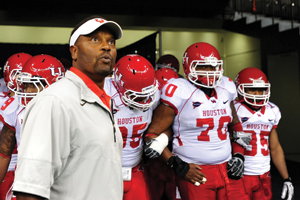Two reports issued late in 2011 highlight some of the positive changes regarding hiring practices in college sports, as well as some of the areas where college athletics is terribly behind the rest of sports regarding issues of diversity and inclusion.
The Black Coaches and Administrators 2011 Football Hiring Report Card showed the power and impact that the BCA and other forces have had on changing the demographics of the sport and how the hiring process operates. Separately, the Campus and Conference Leadership Study highlighted not only the improvement in football, but also how far there is to go in terms of opportunities for women and people of color in decision-making roles at the FBS schools.
The fact is that 91 percent of our presidents are white, 88 percent of our athletic directors are white and 100 percent of our conference commissioners are white. In those positions, 82 percent, 96 percent and 100 percent, respectively, are men. Overall, whites hold 333 (91 percent) of the 365 campus leadership positions reported in the leadership study. Even though there was progress toward diversity, we can hardly say we are close to looking like America when it comes to who is leading college sports.
 |
Kevin Sumlin, who moves to Texas A&M after four years at the University of Houston, was one of three African-American coaches hired at season’s end.
Photo by: GETTY IMAGES
|
However, on the football playing field, significant progress continues to be made among FBS head football coaches. At the beginning of the 2011 season, there was an all-time high of 19 head coaches of color, including 17 African-American head coaches. Six new coaches of color were hired for the 2011 season after a record of seven were hired before the 2010 season.
There have been landmark meetings discussing these issues with many of the power brokers in college and professional sport. The NCAA held an Inclusion Summit in September that brought together some of the leading voices advocating change, along with a group of presidents who brainstormed together in the afternoon after opening presentations.
The espnW Summit, held in October in Arizona, brought together almost all of the key figures regarding Title IX implementation and opportunities for women, including Billie Jean King.
Nonetheless, college sports is still far behind professional sports regarding equal opportunities for the top jobs. For the most part, white men are still running college sports. White men held 100 percent of the FBS conference commissioner positions. Those are the most influential positions in college sports. White men held 75 percent of the 120 president positions and 84 percent of the 120 athletic director positions at FBS football programs. Of faculty athletics representatives, 94 percent of faculty athletics representatives are white and 34 percent are women. Those are the positions where the decisions are made.
Since 1982, there have been 520 head football coaches hired in the Football Bowl Subdivision. African-Americans have been hired 51 times through the 2011 football season. Willie Jeffries was the first, when Wichita State hired him in 1979. There have been two Latino coaches in the history of the FBS schools.
Since the initial BCA Football Hiring Report Card in 2004, African-American head coaches have been hired 31 times. More than half of all the African-American coach hirings have been in the eight years since the publication of the first BCA report card. Furthermore, 27 of the 28 hirings have been in the past six years; 23 of the 28 have been in the last four years. Several coaches have been hired more than once. The BCA Hiring Report Card is clearly an effective tool.
Following the 2011 season, 26 FBS head coaching positions became vacant. Only Penn State has yet to hire a coach to replace Joe Paterno. Of the 25 positions filled, three institutions selected African-Americans to lead their football programs (Texas A&M, Tulane, and Alabama Birmingham). Three African-American coaches were fired, while Kevin Sumlin left Houston to become head coach at Texas A&M. As of the new year, there are 18 coaches of color, of which 15 are African-American.
“It is refreshing to have an opportunity to acknowledge success in the equitable hiring of ethnic minority coaches in Division I collegiate football. I believe it is one of the most shining examples of positive change on the landscape of intercollegiate sport in recent times as it pertains to diversity and inclusion efforts,” said Floyd Keith, executive director of the BCA.
The BCA formula has worked by emphasizing the hiring process, including who is on the search committee, who is interviewed, how long the process takes and whether or not the schools sought help in identifying candidates of color from the BCA and the NCAA Minority Opportunities and Interests Committee.
The NFL took a giant step toward opening its hiring process with the adoption of the Rooney Rule in 2003. Bud Selig, in 1997 on the 50th anniversary of Jackie Robinson breaking the color barrier, mandated that Major League Baseball have a diverse pool of candidates for manager and general manager positions.
Transparency works, and perhaps it is time that all major positions in college athletics are subject to just that so that the leadership positions will have the great leap ahead that has taken place in college football.
Richard E. Lapchick (rlapchick@bus.ucf.edu) is chairman of the DeVos Sport Business Management Graduate Program and the Institute for Diversity and Ethics in Sport at the University of Central Florida. His co-authors of the BCA study were Simone Jackson and Andrew Lilly. Michael Kuhn co-authored the leadership study.





